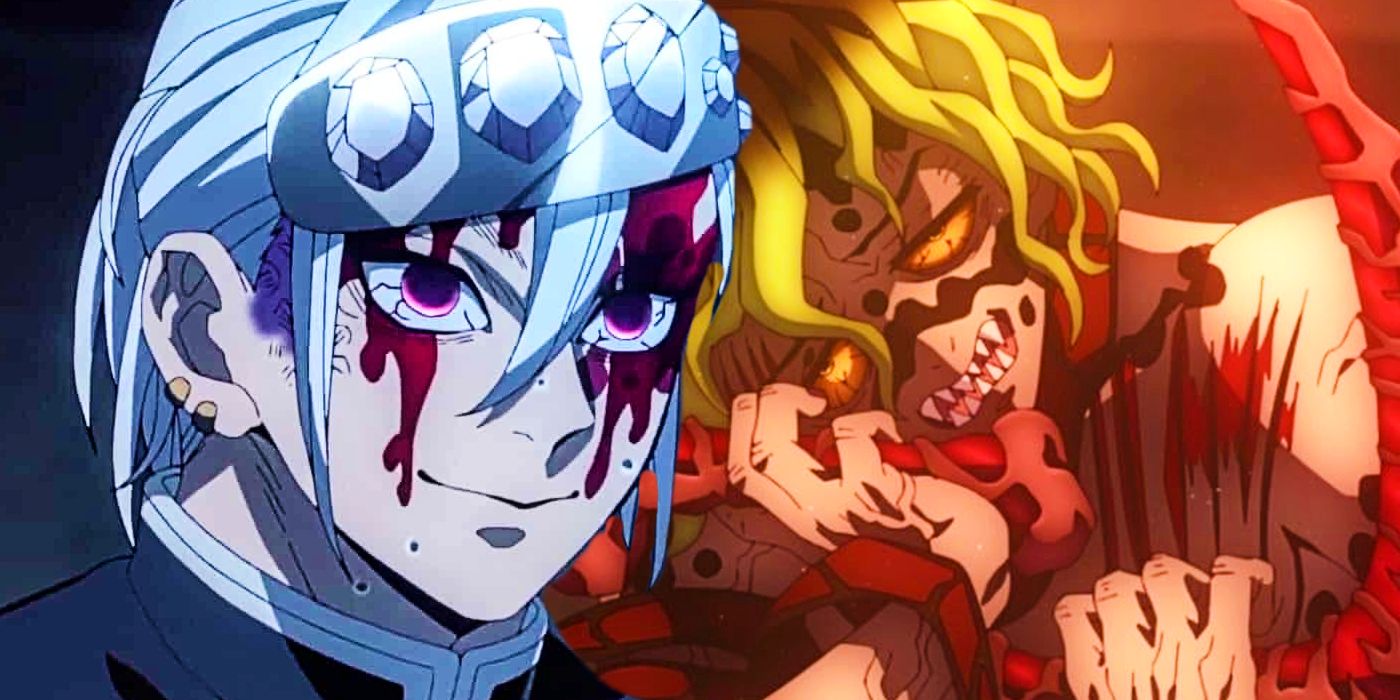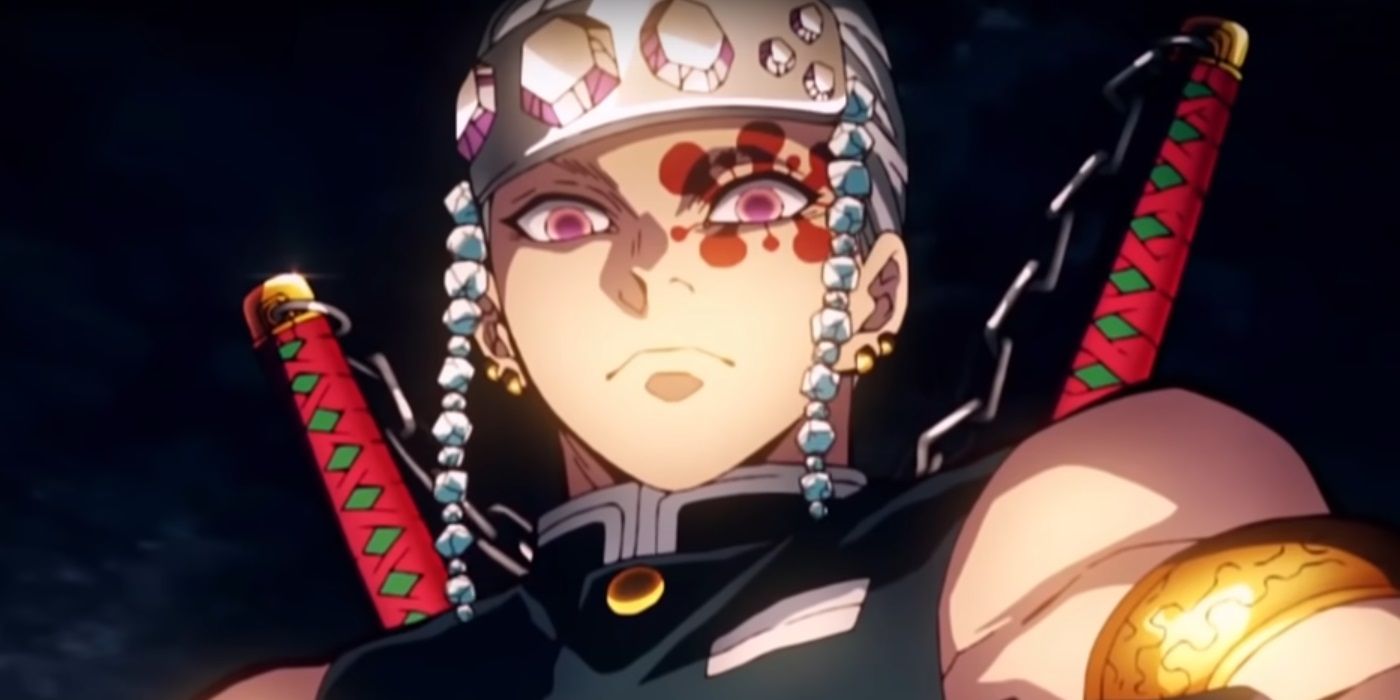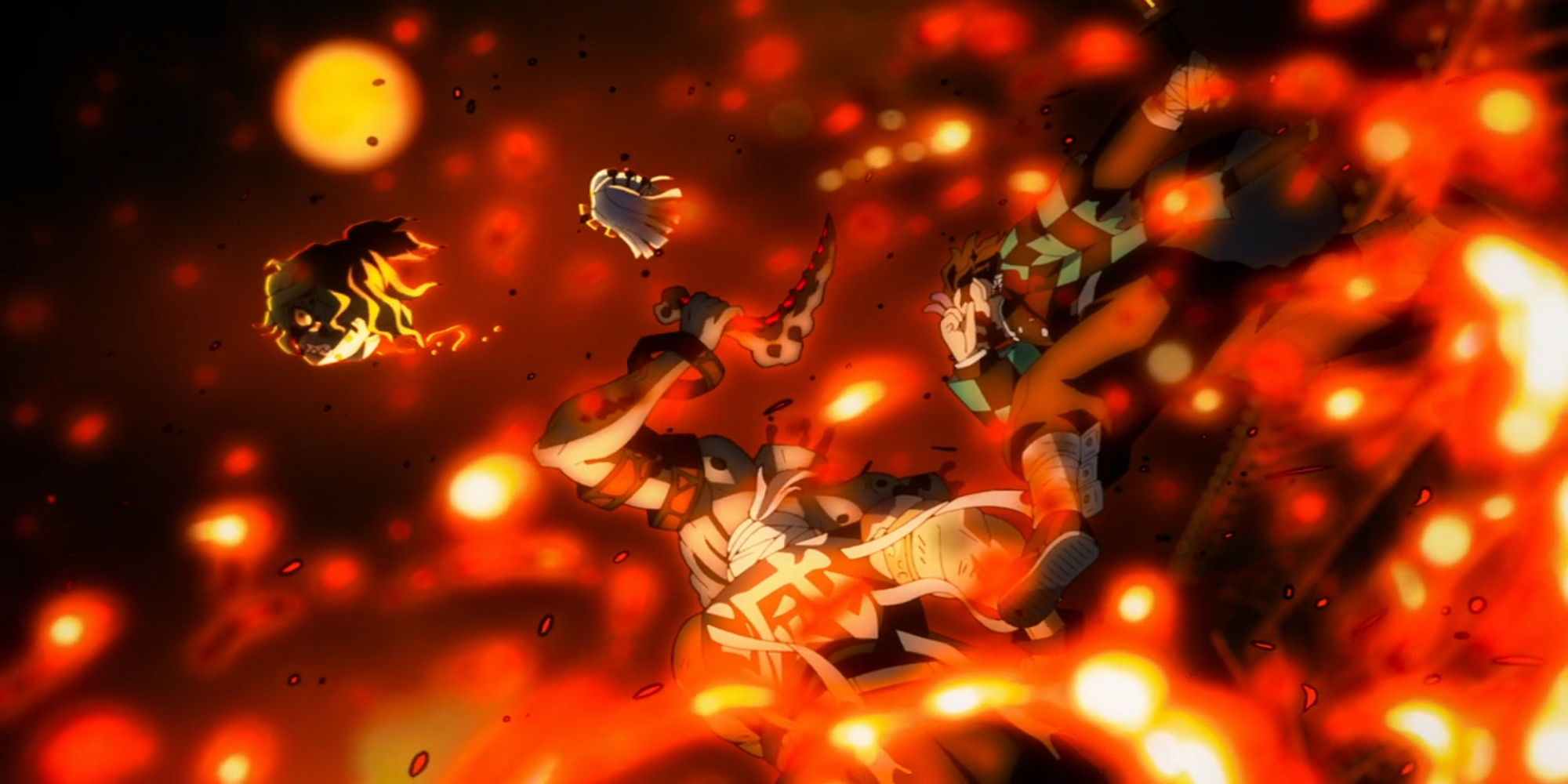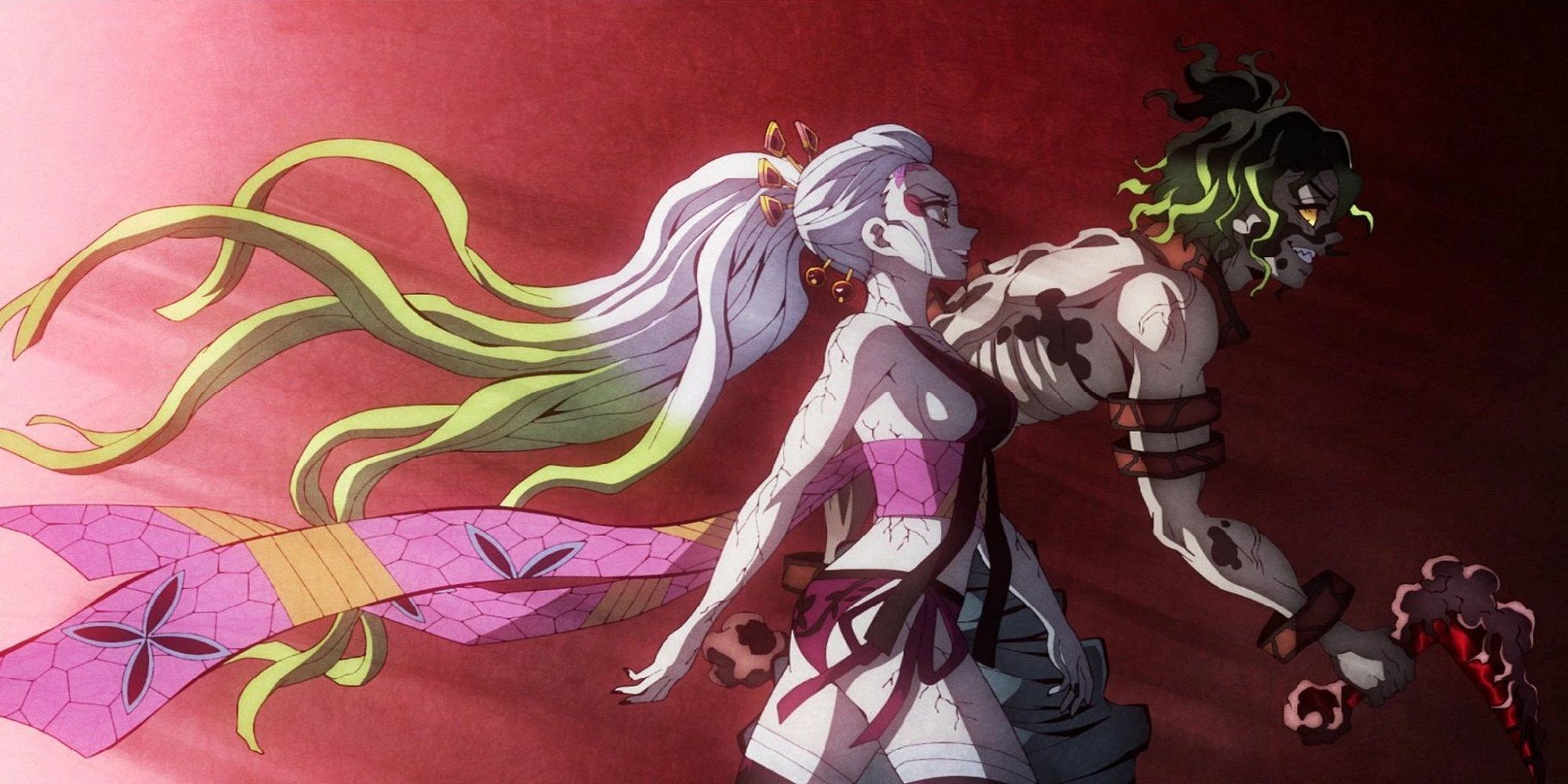Warning: Contains spoilers for Demon Slayer: Kimetsu no Yaiba season 2.
Demon Slayer: Kimetsu no Yaiba season 2 is a great sequel to Mugen Train because of how much it acts in opposition to it. With how much of a critical and commercial success Mugen Train was to the point of being the highest-grossing film of 2020, Demon Slayer season 2 had a lot to live up to from the second it was announced. Fortunately, it more than succeeded at doing so, largely because of how much its story works as a foil to what came before it.
The “Entertainment District” arc picks up immediately where Mugen Train left off. After Tanjiro returns from Rengoku’s home with new information about the Hinokami Kagura, which is actually the Sun Breathing Style, he, Zenitsu, and Inosuke are recruited by the Sound Hashira, Uzui Tengen, to infiltrate the entertainment distract and help him find his three wives who had gone missing while investigating demon activity. Soon enough, it’s discovered that the entertainment district is secretly being controlled by the Upper Rank 6 Kizuki Daki and Gyutaro, and the four of them are dragged into a fight with some of the strongest opponents to be introduced in the series, yet.
Demon Slayer: Kimetsu no Yaiba season 2 managed to take the series to even greater heights and work as a perfect follow-up to Mugen Train, and one reason for that stems from how much it works in parallel to Mugen Train. The characters, the plot, the themes, so many of them serve as foils to what was done in both the Mugen Train movie and earlier parts of the series, as a whole. Thanks to that, not only is the “Entertainment District” arc able to set itself apart from Mugen Train, but it’s also able to add to the overall story by improving on what came before it with new material.
How Tengen Contrasts With Rengoku
The first way that the “Entertainment District” arc creates foils to Mugen Train is with how the Sound Hashira Tengen contrasts with the Flame Hashira Rengoku. Both stories have the main trio of Tanjiro, Zenitsu, and Inosuke being led by a Hashira on a mission, but the two Hashira couldn’t be any more different from each other. The Flame Hashira Rengoku was personable and charming to the point that the three leads were almost immediately taken with him and wanted to be his disciples. Tengen, by comparison, is rude, abrasive, and completely vain and arrogant, even referring to himself as a God, and the main characters spend most of the arc wanting nothing to do with him; Tengen makes his first proper appearance trying to kidnap Aoi and randomly slapping her on the butt, and that more or less establishes the kind of person he is.
Underneath all of the arrogant bluster, however, Tengen is a troubled man plagued with self-doubt. Growing up in a ninja clan where everyone was taught to kill without hesitation, Tengen became a Demon Slayer out of a rejection of that lifestyle and hates how often he fails to save lives out of perceived weakness. The second he realizes that an Upper Rank Kizuki is the demon they’ve been looking for, Tengen, without a hint of his usual bravado, apologizes for dragging the three of them into his business and tells them to go home, and his scenes for the rest of the arc are peppered with dialogues and internal monologues about feeling useless. All of that sets him apart from Rengoku, who was very confident and self-assured about his abilities, even as he was forced to trade blows with Akaza, and Tengen even directly compares himself to Rengoku to drive the point further home.
The dichotomy between the two of them was one of the biggest parts of why the “Entertainment District” arc worked as well as it did. By putting Tanjiro and his friends with a Hashira completely different from Mugen Train's Rengoku such as Tengen, the story is allowed to explore a completely new dynamic from what was done in Mugen Train. Doing that allowed for the arc to feel fresh after everything that happened in Mugen Train, and it makes Tengen, himself, feel like a more unique character by making him so different from what the audience expects out of a Hashira.
How The Entertainment District Fight Contrasts With The Mugen Train Fight
Another way in which the “Entertainment District” arc contrasts with Mugen Train is through the main fights of the respective stories. For Mugen Train, the action was contained mostly to the titular train, which kept things small in scale and overall scope. By comparison, Demon Slayer: Kimetsu no Yaiba's “Entertainment District” arc has its action spread out across the titular neighborhood, which allows for the characters to move around into a wider assortment of scenes that all have a unique flair to them. The larger area also meant that the characters were able to cause more destruction with their attacks, which results in the environment going through more changes through the fight — the entertainment district is left a smoldering wasteland by the end of the arc — and allows for a much bigger showing of everyone’s abilities to up the already impressive spectacle of it all.
More importantly, the “Entertainment District” arc puts Tanjiro, Zenitsu, Inosuke, and even Tanjiro's sister, Nezuko at the forefront of the action. In Mugen Train, even before Akaza showed up, Rengoku was doing the most work by protecting the majority of train passengers from harm while the four of them were left with the comparatively smaller tasks of protecting a smaller amount of passengers and finishing off Enmu when he had evolved into a less mobile form. In the “Entertainment District” arc, however, Daki and Gyutaro are the only threats to be dealt with, so they’re forced to deal with them just as much as Tengen is. The change in their role in the fight works well to establish not only that this arc is the point in the Demon Slayer anime where every enemy going forward is going to be a high-level threat, but that Tanjiro and his friends now have the strength to deal with them, even if only by working together. There always needed to be a point where they would have to stop being at the bottom, and the “Entertainment District” arc makes it clear that they’ve reached that point.
How Tanjiro And Nezuko Contrast With Gyutaro And Daki
One of the best points of contrast from the “Entertainment District” arc, however, comes in relation to the entire series, and it’s Tanjiro and Nezuko’s relationship contrasted with Gyutaro and Daki’s. Both pairs of siblings grew up in poverty and at least found comfort in being with each other, but their lives came to an abrupt end when tragedies struck the pairs: Tanjiro’s family were killed by Muzan and Nezuko was turned into a demon at the beginning of the Demon Slayer anime, and Daki — originally named Ume — was burned alive for stabbing a client, with Gyutaro being fatally wounded in the aftermath. Both pairs of siblings found salvation at their lowest points, with Tanjiro meeting Tomioka, who set him on the path to becoming a Demon Slayer and finding a cure for Nezuko, while Gyutaro met Doma, who saved him and Ume by turning them into demons.
The stories that the two pairs of siblings went through greatly contrast each other. The fact that one pair chose a heroic path and another a villainous one is clear, but in addition to that, the Demon Slayer anime makes it clear that while Tanjiro and Nezuko never let the hardships of their situation weigh them down, Gyutaro was spiteful towards the world and people he perceived as being more fortunate than him even before he became a demon. Gyutaro and Daki are a dark reflection of how Tanjiro and Nezuko could have turned out, something the show even explicitly states a few times, and it’s part of what sells the arc.
Tanjiro and Nezuko’s relationship is the backbone of Demon Slayer, and seeing it be contrasted with a dark reflection of itself both reminds the audience of how important the relationship is and makes it even stronger in retrospect. That, in turn, feeds into what made season 2 work so well: contrast. Whether it’s to the Mugen Train movie right before it, or elements from even earlier in the series, so much of the “Entertainment District” arc works by contrasting against other parts of the series to elevate the quality of its own content, and from start to finish, it works extremely well. Because of that, Demon Slayer season 2 was able to be an excellent continuation of the series that, with any luck, will also pave the way for a great season 3.




